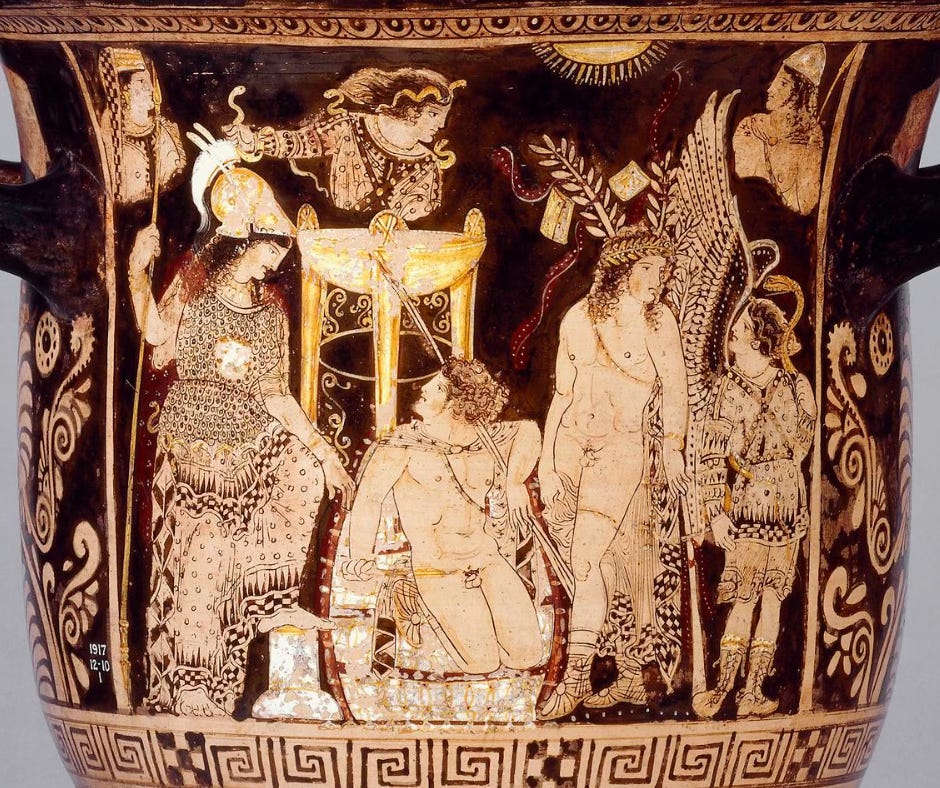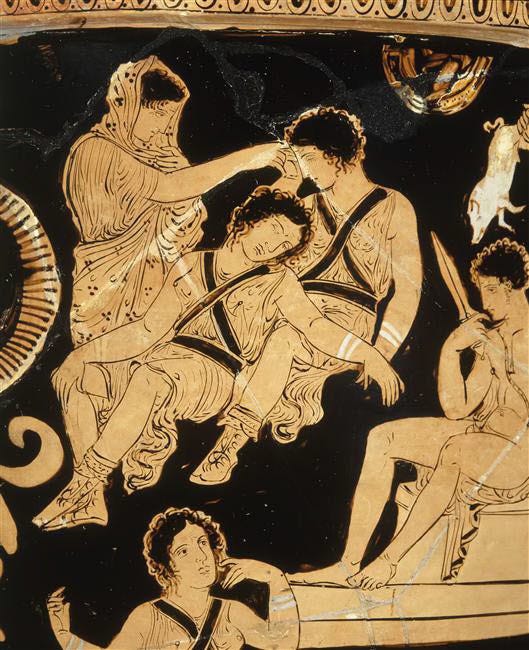The Orphic Hymn of the Erinyes (Furies) & (Bonus!) Hymn of the Eumenides
TWO New Translations plus Live Chat on 2/16/25, 2pm EST
Business first: You’ll find the new translations of the Hymns of Erinyes (Furies) & of Eumenides at the end of this post, along with the link to the upcoming LIVE CHAT on 2/16/25, 2pm EST that will offer more detail (especially on the esoteric bits), and a chance for Q & A.
Please read this essay through before you scroll to the hymns, because I give you some practical tips on these goddesses that are important to observe when engaging with them. I don’t say this about all the hymns I publish, but these are two that require some careful attention when you read them.
A Loud Dream
It began with a feeling. An unrelenting nagging of something (what?) tugging at the sleeves of my mind.
Then, one night in late January, a dream. Running through the woods, breathless, heart pounding, and a single Greek word ringing in my ears when I awoke: “EUAI!”
If you’ve heard that word before, it’s probably been in the context of Dionysian revels - it’s the word Maenads (also known as the Bacchae) cry in honor of the God as they race through the countryside in wild abandon.
But when I awoke the other morning, something told me it was not Dionysius or even the Bacchae that were calling me. I had been in the middle of translating a different hymn, but when I sat down at my desk that morning, I couldn’t pick up where I left off. I found myself, instead, turning almost automatically to the hymn of the Erinyes, known to most of us by their later Roman name of the Furies. I didn’t know why, but something about that dream (the pursuit? my breathless panic?) nudged me towards their hymn.
I had never read the Greek of the Orphic Hymn of Erinyes closely, but when I glanced through it this time, there it was: not one, but TWO unmistakable references to the Erinyes’ shouting “EUAI!” as they pursue their prey. (In this case, me!)
So. I put aside my other translation and settled down with the Furies. When they demand your attention, it seems wise to listen.
In the process, I learned a LOT (some of it the hard way) about how to engage with these goddesses - both the Erinyes themselves and the Eumenides, their (somewhat?) kinder, gentler alter egos. So please read this through before you scroll to the hymns themselves.

You say “the Furies,” and I say “Erinyes”
Before we dive in, let’s talk pronunciation, since it tends to stumble English-speakers up: “Erinyes” is pronounced “eh-rin-OO-ehs” or sometimes “eh-RIN-wehs,” depending on context). It is the plural form of the singular Erinys (pronounced “eh-rin-OOS”).
It was the Romans who gave the goddesses the name “the Furies.” “Furies” is a lot easier for English speakers to say, but it tends to encode a lot of Roman (and our own) ideas of fury, wrath, vengeance and so forth in the word, so I prefer “Erinyes” when I am among folks who will understand what I’m talking about. (That’s you!)
We usually use the plural when talking about these goddesses because there are traditionally three of them, though Hesiod’s Theogony (which is the earliest Greek mention of them, in lines 176-187) doesn’t mention a specific number. And the very EARLIEST mention of a similar deity (the Mycenaean goddess Erinus, about whom we know very little) is in the singular. But for simplicity’s sake, let’s give them their traditional names:
Tisiphone (meaning “Slaughter-Avenger”)
Allekto (meaning “Unceasing”)
Megaira (meaning “Grudge”)
Collectively, the Erinyes were so named, the Greeks believed, because they stirred things up (from the verb orinō), or because they tracked you down (from the verb ereunaō) and caused strife (eris).

The Erinyes and the Eumenides
The Erinyes are almost always found in the company of another triad of goddesses, the Eumenides (pronounced: You-MEN-i-deez). In fact, by the Classical period, the two sets of goddesses were usually believed to be “before” and “after” versions of the same divinities.
To somewhat oversimplify, from about the mid-5th c. BCE onwards, the Eumenides were thought of as the kinder, gentler form of the Erinyes themselves. The two triads were given different names in honor of their different effects on the body-mind-soul.
Both are powerful, dread-inducing goddesses bent on justice. In Classical Greco-Roman Myth (influenced very much by the depiction of them in Aeschylus’ play The Eumenides, first performed in 458 BCE), the Erinyes bring about frenzied madness and bloodlust, whereas the Eumenides bring about reasoned, democratic judicial systems and the flourishing societies that such systems engender.
This dichotomy between the two sets of goddesses became part and parcel of the founding myth of Athenian democracy. Aeschylus’ play ends with the Erinyes TRANSFORMING INTO the Eumenides, and the democratic state of Athens receiving all the blessings of the newly kind and gracious goddesses.
That is certainly one way to think of the Erinyes/Eumenides, and perhaps it even bears a closer look during these times when democracy and the common people are under attack by the forces of tyranny and chaos. There’s an interesting intersection in this traditional myth of the Erinyes between madness, dysfunctional family systems, and the tyranny of the state.
(If folks are interested, I can always explore this connection with the foundation of democracy in later posts/chats, because I’ve spent quite a bit of time with the Aeschylus text, including translating/unpacking its magical language. Just lmk in the comments if you’d be interested.)
However, the Orphics don’t see the Erinyes/Eumenides in quite the same way as did Aeschylus and the state-sponsored religious traditions. For them, the goddesses do seem to be (sort of? kinda?) different facets of the same divinities, but as we might expect, the Orphics describe the goddesses in WAAAY more cosmic terms than the mainstream version of the deities that became popular in the centuries after the Orphic material was written.
Roughly, we could put the timeline like this:
1400-1200 BCE First mention of a goddess (Erinus) in tablets from Mycenaean Crete (written in the ancient script of Linear B). She is mentioned as being given olive oil in a list of offerings.
700-500 BCE Consolidation of Orphic material found in the Orphic Hymns. The Hymns of Erinyes and Eumenides are paired, but without explicit commentary on their relationship.
458 BCE Aeschylus writes his tragic trilogy “The Oresteia,” which wins first prize in the Dionysian Festival. “The Eumenides” is the third and last play in the series, and it depicts the change of the Erinyes to the Eumenides in the context of the Athenian democratic system.
400-300 BCE Many, many vase paintings are produced featuring the scenes depicted in Aeschylus’ play. The Erinyes themselves are depicted in various ways - singly or together, with wings and without, bedecked in snakes or not.

Erinyes/Eumenides: Handle with Care, and Always in a Pair
I just made that slogan up, but it basically summarizes my most important lesson from dealing with the act of translating these hymns, and that is: DO NOT INVOKE THE ERINYES WITHOUT INVOKING THE EUMENIDES TOO!
These are not goddesses you can just invoke or immerse yourself in without some form of buffer or cushioning protection. In the past week or two, as I’ve been working with the hymn, I’ve experienced an upsurge in panic, dysautonomic crashes (related to my Long Covid), and general dis-ease. Only engaging with the accompanying Hymn of the Eumenides has slowed this down.
Here’s what I have learned (the hard way):
Set up a ritual space (even as simple as lighting a candle that you can blow out at the end) in order to read these hymns. Make sure you close it down at the end.
ALWAYS read both hymns together unless you really want to experience the full effect of the Erinyes (which I wouldn’t recommend, frankly). The original Orphics grouped them together in the sequence of hymns, and surrounded them by lots of protective deities.
If you are magically inclined, read it through once or twice to get the “vibe” of it before doing any working. The hymn has magically protective language built in, but it’s important to discern for yourself which lines to “lean into” when reciting it.
Take care of yourself with soothing tea (I like Wood Betony or Linden), a walk outside, or whatever else calms your nervous system.
Pay attention in the coming days to your regulation/dysregulation, since sometimes the effect isn’t immediate. If you find yourself discombobulated, I’d read the Hymn of Hygeia as a regulating method.

Questions for Yourself as you Read
(There aren’t necessarily any “right” answers to these. We’ll discuss further at the Live Chat on 2/16/25 at 2pm EST - link is here)
Rather than just spell out all the things I’ve noticed while translating the hymns, I prefer to call on your own discernment/judgement by providing a list of questions. This is very much in keeping with the Erinyes/Eumenides, who are themselves ALL ABOUT making judgements. So with that in mind, here are some things to ponder:
Where do the hymns seem to take place?
How are the goddesses described? Where do the descriptions overlap and where do they differ?
What is their lineage or family? With whom are they associated?
What is their relationship to Justice? to Necessity and the Moirae? to mortal beings?
What is their relationship to light and dark?
What are they asked for at the end of each hymn?
That’s all folks! I hope I didn’t scare you with all the caveats about working with these hymns. These ARE incredibly important goddesses in the Orphic system, and with the right precautions/attention they can bring deep insight.
I hope to see you in the Live Chat so we can explore the hymns together, but if you can’t make it, there will ofc be a recording.






